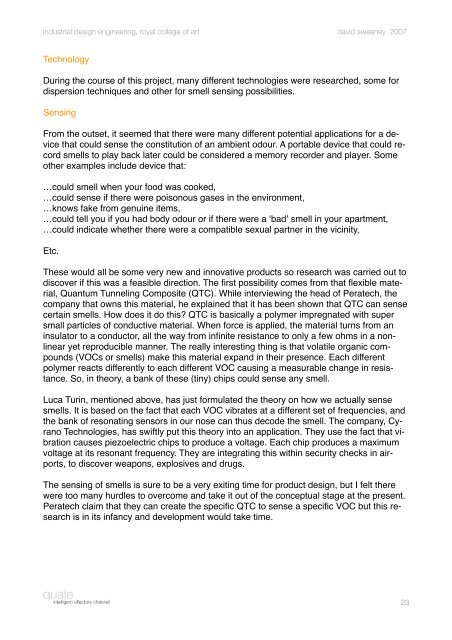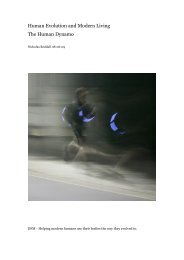industrial design engineering, royal college of art david sweeney ...
industrial design engineering, royal college of art david sweeney ...
industrial design engineering, royal college of art david sweeney ...
Create successful ePaper yourself
Turn your PDF publications into a flip-book with our unique Google optimized e-Paper software.
<strong>industrial</strong> <strong>design</strong> <strong>engineering</strong>, <strong>royal</strong> <strong>college</strong> <strong>of</strong> <strong>art</strong> <strong>david</strong> <strong>sweeney</strong> 2007<br />
Technology<br />
During the course <strong>of</strong> this project, many different technologies were researched, some for<br />
dispersion techniques and other for smell sensing possibilities.<br />
Sensing<br />
From the outset, it seemed that there were many different potential applications for a device<br />
that could sense the constitution <strong>of</strong> an ambient odour. A portable device that could record<br />
smells to play back later could be considered a memory recorder and player. Some<br />
other examples include device that:<br />
…could smell when your food was cooked,<br />
…could sense if there were poisonous gases in the environment,<br />
…knows fake from genuine items,<br />
…could tell you if you had body odour or if there were a ‘bad’ smell in your ap<strong>art</strong>ment,<br />
…could indicate whether there were a compatible sexual p<strong>art</strong>ner in the vicinity,<br />
Etc.<br />
These would all be some very new and innovative products so research was carried out to<br />
discover if this was a feasible direction. The first possibility comes from that flexible material,<br />
Quantum Tunneling Composite (QTC). While interviewing the head <strong>of</strong> Peratech, the<br />
company that owns this material, he explained that it has been shown that QTC can sense<br />
certain smells. How does it do this? QTC is basically a polymer impregnated with super<br />
small p<strong>art</strong>icles <strong>of</strong> conductive material. When force is applied, the material turns from an<br />
insulator to a conductor, all the way from infinite resistance to only a few ohms in a nonlinear<br />
yet reproducible manner. The really interesting thing is that volatile organic compounds<br />
(VOCs or smells) make this material expand in their presence. Each different<br />
polymer reacts differently to each different VOC causing a measurable change in resistance.<br />
So, in theory, a bank <strong>of</strong> these (tiny) chips could sense any smell.<br />
Luca Turin, mentioned above, has just formulated the theory on how we actually sense<br />
smells. It is based on the fact that each VOC vibrates at a different set <strong>of</strong> frequencies, and<br />
the bank <strong>of</strong> resonating sensors in our nose can thus decode the smell. The company, Cyrano<br />
Technologies, has swiftly put this theory into an application. They use the fact that vibration<br />
causes piezoelectric chips to produce a voltage. Each chip produces a maximum<br />
voltage at its resonant frequency. They are integrating this within security checks in airports,<br />
to discover weapons, explosives and drugs.<br />
The sensing <strong>of</strong> smells is sure to be a very exiting time for product <strong>design</strong>, but I felt there<br />
were too many hurdles to overcome and take it out <strong>of</strong> the conceptual stage at the present.<br />
Peratech claim that they can create the specific QTC to sense a specific VOC but this research<br />
is in its infancy and development would take time.<br />
23



